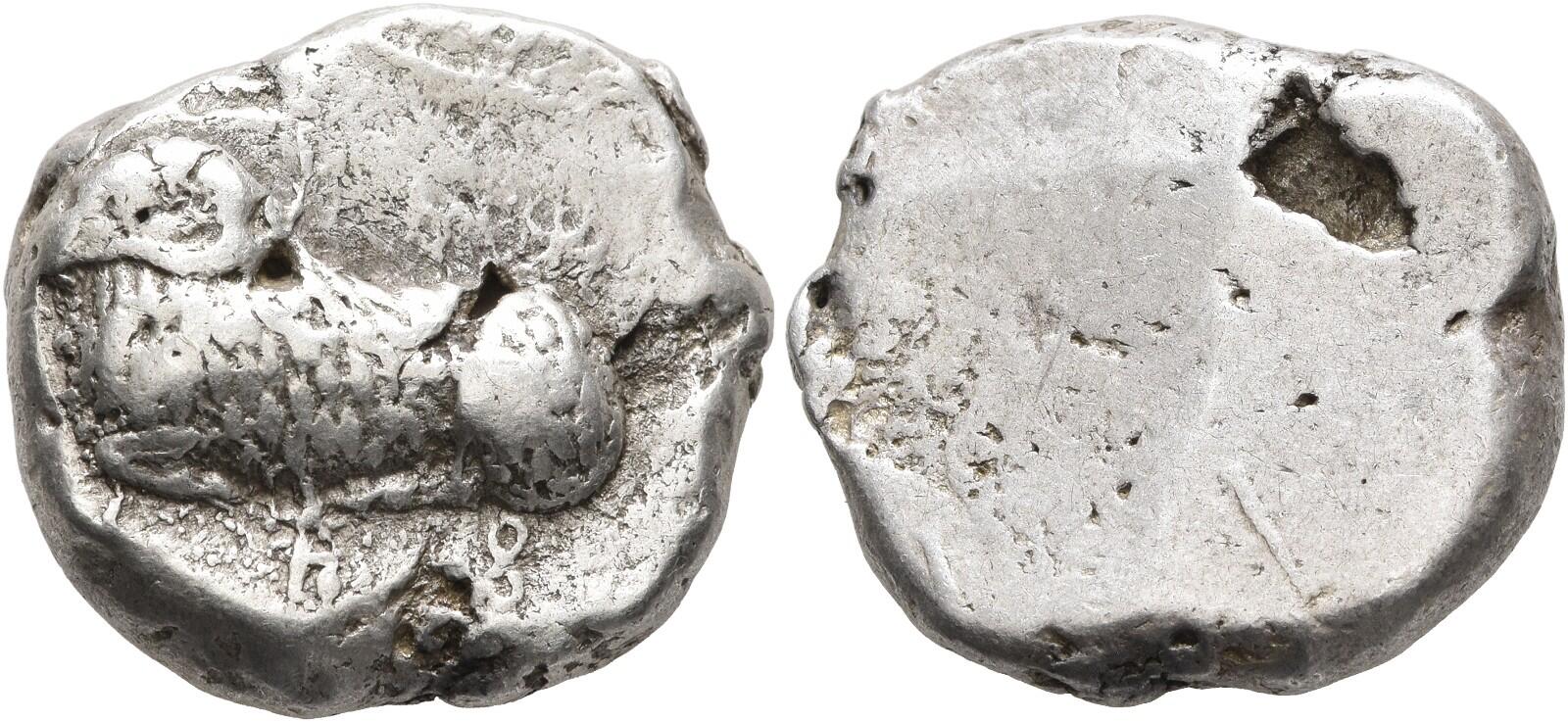S 2118 - Salamis (Euelthon I), silver, staters (530-500 BCE)
From SILVER
530 BCE - 500 BCE Silver 23,790 kg
Description
| ObverseInscription or printing placed on the obverse.: | 𐠁[𐠄𐠳]-𐠐𐠰[𐠚] ('[E-[u-fe]-le-tho-[ne]' in Cypriot syllabic script) (Cypriot).Ram recumbent to left |
| ReverseInscription or printing placed on the reverse.: | Blank |
Mint and issuing power
| MintIdentifies the place of manufacture or issue of a numismatic object.: | Salamis | Ancient regionAncient region.: | Cyprus | Modern countryModern country: Turkey | AuthorityIdentifies the issuing power. The authority can be "pretended" when the name or the portrait of X is on the coin but he/she was not the issuing power. It can also be "uncertain" when there is no mention of X on the coin but he/she was the issuing power according to the historical sources: | Euelthon of Salamis (king of Salamis, last quarter of the 6th c. BC) |
Chronology
| FromIdentifies the initial date in a range assigned in a numismatic context. | 530 BCE | toIdentifies the final date in a range assigned in a numismatic context.. | 500 BCE | PeriodTime period of the numismatic object.: Archaic until 480 BC |
Physical description
| MetalThe physical material (usually metal) from which an object is made.: | Silver |
Median weightMedian of the weights of numismatic objects (in grams). in grams | 10.80 | DenominationTerm indicating the value of a numismatic object. Examples: tetradrachm, chalkous, denarius.: | stater |
StandardStandard.: |
Image

S2118 Salamis 530-515 staters.jpg [1]
References
| Die study referencePublication of the study: | McGregor 19991McGregor 1999, p. i-xi, Tziambazis 20022Tziambazis 2002, n° 95 | ||
| Coin series referenceReference to coin series study: | |||
| Coin series web referenceCoin series web references: | |||
Obverse dies distribution
| FrequencyFrequency of specimen in distribution. ᵖ | Number of obversesNumber of obverse dies. ᵖ (o) | % (o) | Number of coinsNumber of coins. (n) | % (n) | Die nameName(s) of the die(s). |
| 1 | 40 | 68.97 | 40 | 39.6 | 2, 7, 21, 22, 23, 24, 25, 26, 27, 28, 29, 30, 31, 32, 33, 34, 35, 36, 37, 38, 39, 40, 41, 42, 43, 44, 45, 46, 47, 48, 49, 50, 51, 52, 53, 54, 55, 56, 57, 58 |
| 2 | 7 | 12.07 | 14 | 13.86 | 5, 8, 11, 13, 16, 18, 20 |
| 3 | 4 | 6.9 | 12 | 11.88 | 3, 6, 12, 15 |
| 4 | 2 | 3.45 | 8 | 7.92 | 4, 17 |
| 5 | 4 | 6.9 | 20 | 19.8 | 1, 9, 14, 19 |
| 7 | 1 | 1.72 | 7 | 6.93 | 10 |
| Total | 58 of 58 | 100.01 | 101 of 101 | 99.99 |
Reverse dies distribution
no distribution is available
Quantification
| Number of obversesNumber of obverse dies. ᵖ (o) | 58 | Number of singletons (o1)The number of singleton coins. ᵖ | 40 |
| Number of reverse diesNumber of reverse dies. (r) | Number of coinsNumber of coins. (n) | 101 | |
| Coins per obverse dieNumber of coins per obverse die. (n/o) | 1.74 | Coins per reverse dieNumber of coins per reverse die. (n/r) | |
| Reverse per obverse ratioRatio of obverse dies divided by reverse dies. (r/o) | Percentage of singletons (o1)number of coins (n) divided by the number of singletons (o1) ᵖ | 68.97 % | |
| Original number of dies (O) (Carter 1983 formula)The estimation of the number of coins according to Carter 1983 ᵖ | 110.14 | Coins struck if 20,000 as average productivity per dieCoins made if the average productivity for obverses (according to Carter) is 20,000. ᵖ | 2,202,800 |
| Original number of dies (O) (Esty 2011 formula)The estimation of the number of coins according to the singleton formula in Esty 2011 ᵖ (O) | 136.23 | Survival rate if 20,000 as average productivity per dieSurvival rate if average productivity is 20,000. ᵖ | 0.00005 |
| Coverage (o = % of O) (Esty 1984 formula)Esty 1984 - coverage (% of O) ᵖ (o = % of O) | 60.4% | Die productivity if survival rate 1/2,000Average productivity if survival rate is 1/2,000. ᵖ | 1,834.03 |
| Weight of silver (in kg) if 20,000 coins per die (O = Carter formula)Carter 1983 * Median weight * 20000 (*10 if gold or electrum) ᵖ | 23,790 kg <br /> 23,790 kg | Die productivity if survival rate 1/5,000Average productivity if survival rate is 1/5,000. ᵖ | 4,585.07 |
Remarks